Extraction of a high-fidelity 3D medial axis is a crucial operation in CAD. When dealing with a polygonal model as input, ensuring accuracy and tidiness becomes challenging due to discretization errors inherent in the mesh surface. Commonly, existing approaches yield medial-axis surfaces with various artifacts, including zigzag boundaries, bumpy surfaces, unwanted spikes, and non-smooth stitching curves. Considering that the surface of a CAD model can be easily decomposed into a collection of surface patches, its 3D medial axis can be extracted by computing the Voronoi diagram of these surface patches, where each surface patch serves as a generator. However, no solver currently exists for accurately computing such an extended Voronoi diagram. Under the assumption that each generator defines a linear distance field over a sufficiently small range, our approach operates by tetrahedralizing the region of interest and computing the medial axis within each tetrahedral element. Just as SurfaceVoronoi computes surface-based Voronoi diagrams by cutting a 3D prism with 3D planes (each plane encodes a linear field in a triangle), the key operation in this paper is to conduct the hyperplane cutting process in 4D, where each hyperplane encodes a linear field in a tetrahedron. In comparison with the state-of-the-art, our algorithm produces better outcomes. Furthermore, it can also be used to compute the offset surface.
翻译:暂无翻译




